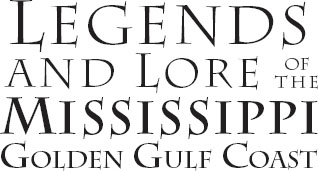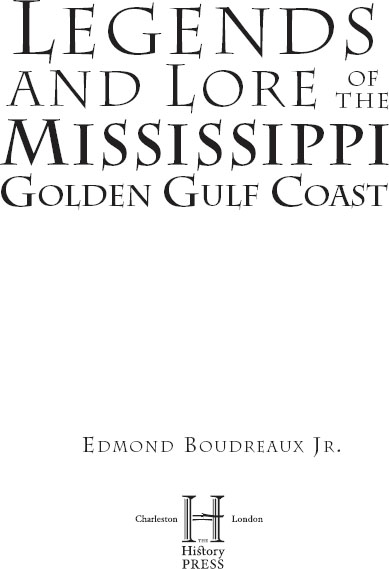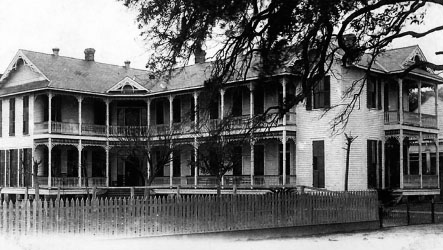Legends and Lore of the Mississippi Golden Gulf Coast
Read Legends and Lore of the Mississippi Golden Gulf Coast Online
Authors: Edmond Boudreaux Jr.




Published by The History Press
Charleston, SC 29403
Copyright © 2013 by Edmond Boudreaux Jr.
All rights reserved
Front cover, bottom:
Michael McCarthy (MSMcCarthy Photography). All other cover images are from the Alan Santa Cruz Collection.
First published 2013
e-book edition 2013
Manufactured in the United States
ISBN 978.1.61423.925.3
Library of Congress CIP data applied for.
print edition ISBN 978.1.60949.904.4
Notice
: The information in this book is true and complete to the best of our knowledge. It is offered without guarantee on the part of the author or The History Press. The author and The History Press disclaim all liability in connection with the use of this book.
All rights reserved. No part of this book may be reproduced or transmitted in any form whatsoever without prior written permission from the publisher except in the case of brief quotations embodied in critical articles and reviews.
C
ONTENTS
1. Mississippi's Golden Gulf Coast
2. The Legend of Captain Patrick Scott's Buried Treasure
3. Carved Magnolias and the Pirate Jean Lafitte
4. Jean Lafitte's Deer Island Treasure
5. The Legend of the Pitcher Point Pirates
6. The Pirates' Cave: Legend of the Pirate House
7. The Legends of the Ghost of Blue Fire and the Headless Ghost of Deer Island
8. The Legend of the Beautiful Ghost of Krebs Lake
9. The Indian Legend of the Singing River
10. The Indian Legend of the Ring in the Oak
12. D'Iberville and the Opossum
14. Letter from Cat Island: The Battle of New Orleans
16. Jefferson Davis: A Vision of His Early Life
17. The Day the Liberty Bell Visited Mississippi's Golden Gulf Coast
18. Pascagoula's Old Spanish Fort and Cannons
19. The Monte Carlo of the South
21. George E. Ohr: The Mad Potter of Biloxi
23. The Ship Island Lighthouses
26. Roosevelt's Visit to Biloxi
27. Pass Christian's Dixie White House and President Woodrow Wilson
28. The 1925 Mardi Gras Carnival's Water and Street Parade
29. Biloxi: Birthplace of Barq's Root Beer
A
CKNOWLEDGEMENTS
While many years of my own research have gone into this book, certain people have made this book possible. This encompasses a special group of local historians that includes Julia Cook Guice, Mary Louise Adkinson, Murella Hebert Powell, Kat Bergeron and Dr. Val Husley.
In 1985, I became involved with the Maritime & Seafood Industry Museum located in Biloxi. It developed into a first-class museum, but in 2005 Hurricane Katrina destroyed the building and all the exhibits less than one year after a total remodeling and addition to the museum. Today, it has a temporary location in the Edgewater Mall and is in the process of rebuilding. The museum's records, documents and pictures played a big part in the research of this book.
Thank you to Alan Santa Cruz, who allowed his collection of Gulf Coast postcards to become an important part of this book.
The Local History and Genealogy Department of the Harrison County Library System also deserves special thanks. Its collection of historic photographs, documents, newspapers, directories and other records have been instrumental in the research of this book.
I would also like to thank The History Press for recognizing the historical legends and lore of Mississippi's Golden Gulf Coast through the printing of this book.
To Virginia, my wife, a very special appreciation for editing my work and keeping me straight.
I
NTRODUCTION
During the 1970s, Captain Joe Scholtes became a tour guide and historical interpreter of Mississippi's Golden Gulf Coast. He hoped to promote tourism and brought tourism dollars to the whole Gulf Coast. He coined the phrase “Mississippi's Golden Gulf Coast” while selling Mississippi's Golden Gulf Coast as a tourist destination where visitors could soak up the sun while enjoying a variety of activities, including swimming, fishing and golfing. He was also selling Mississippi's Golden Gulf Coast as a place rich in history, structures, legends and lore.
There were numerous historical homes, like the Pirate House; St. Stanislaus School; the Dixie White House; Ballymere; the Mississippi Centennial buildings on the Gulfport Veterans' Administration grounds; Beauvoir, the last home of Jefferson Davis; Father Ryan's Home; Old (Biloxi Cemetery) French Cemetery; Biloxi Lighthouse; Ancient Burial Grounds (Moran Art Studio) on Porter Avenue; Magnolia Hotel; Old French House; Spanish House; Le Moyne Galleries; Church of the Redeemer and the Ring in Oak; Seashore Methodist Assembly; St. Michael Catholic Church, the fishermen's church; Old Place Plantation; Long Fellow House; Old Spanish Fort and Museum; and many more.
Rooted deep in the Golden Gulf Coast history and the history of its structures were legends and lore, retold from generation to generation while being modified and refined. It is hard to separate fact from fiction in many of these legends and lore, but they do give us a window into Mississippi's Golden Gulf Coast culture. Some legends are believed to be fact but are just well-crafted tales that entertain and amuse us. Mixed with historical facts, they become a part of the history of the Mississippi's Golden Gulf Coast. This book will explore and separate the facts and fiction of these historic legends, as well as how they have evolved over time and gained lives of their own. These legends and historical lore have become part of the fabric of Mississippi's Golden Gulf Coast culture and a piece of its history.
CHAPTER 1
M
ISSISSIPPI
'
S
G
OLDEN
G
ULF
C
OAST
The first mention of Mississippi's Golden Gulf Coast appears in a booklet entitled
The First Edition 1970â71 Tour Guide & History of Mississippi's Golden Gulf Coast: From New Orleans to Mobile
. The brainchild of Captain Joe Scholtes and his wife (referred to as “his mate” on the cover of the booklet), the guide is a window into the 1970s Golden Gulf Coast. This is very recent history, but the changes that have occurred on the Mississippi Golden Gulf Coast since 1970 are amazing. Aboard the
Sailfish
, Captain Joe Scholtes conducted tours of Biloxi Harbor, including shrimping and oystering exhibitions. During his life, he collected numerous historical photographs of the Mississippi Gulf Coast. Some of this collection would later be published as
Biloxi and the Mississippi Gulf Coast: A Pictorial History
, by Colleen C. Scholtes and L.J. (Joe) Scholtes.
The three coast counties have grown by 38.8 percent over a period from 1970 to 1990. In 1970, the Mississippi Gulf Coast was still recovering from Hurricane Camille. Joe's opening letter to visitors indicates that the Golden Gulf Coast is “slightly tarnished at the moment, please remember we are still recovering from a most unladylike visit.” The guide indicates that the “Mississippi's Golden Gulf Coast extends from New Orleans to Mobile.” Scholtes reports that the sister cities of Bay St. Louis, Pass Christian, Long Beach, Gulfport, Biloxi, Ocean Springs and Pascagoula form the Golden Gulf Coast.
The guide contains a brief history of each city but then describes activities, sights to see, restaurants, motels, hotels and miscellaneous information. This is a basic look at businesses and sites that were either restored or suffered little damage after Camille's destructive visit. The guide begins on Old Spanish Trail, U.S. Highway 90, in New Orleans, Louisiana, and ends in Mobile, Alabama.

Courtesy of the Maritime & Seafood Industry Museum
.

The Tulane Hotel, Bay St. Louis.
Courtesy of Alan Santa Cruz Collection
.
Here is a look at the 1970 cities, history and places listed in the guide. Bay St. Louis is the seat of Hancock County, with a 1970 population of ten thousand. Scholtes indicates that General Thomas Shields built two houses near the mouth of the bay. This settlement became known as Shieldsboro. Scholtes reports that the name was changed to Bay St. Louis, and in 1858, the city was incorporated.
In Bay St. Louis, the guide lists the Bay-Waveland Yacht Club on Beach Drive as a point of interest. Other points of interest were St. Augustine's Seminary, located on Highway 90, and St. Stanislaus College, a Catholic elementary and secondary boarding school for boys on South Beach. St. Stanislaus was founded in 1855. Boys from New Orleans, Mobile and the entire Mississippi Gulf Coast, as well as from other states, have attended St. Stanislaus. Some students have come from as far away as Cuba, Mexico and Venezuela. In 1970, the school averaged about five hundred students a year. Horne's Restaurant on U.S. 90 and Ramada Inn & Restaurant are the only restaurants and motels listed.
